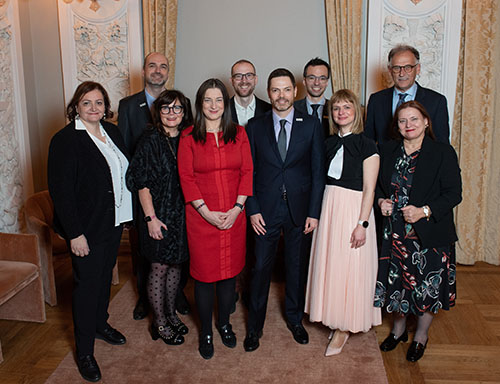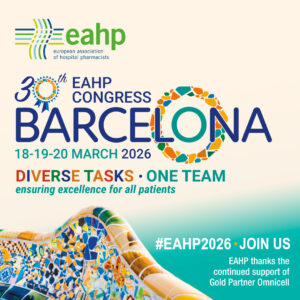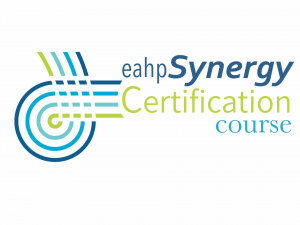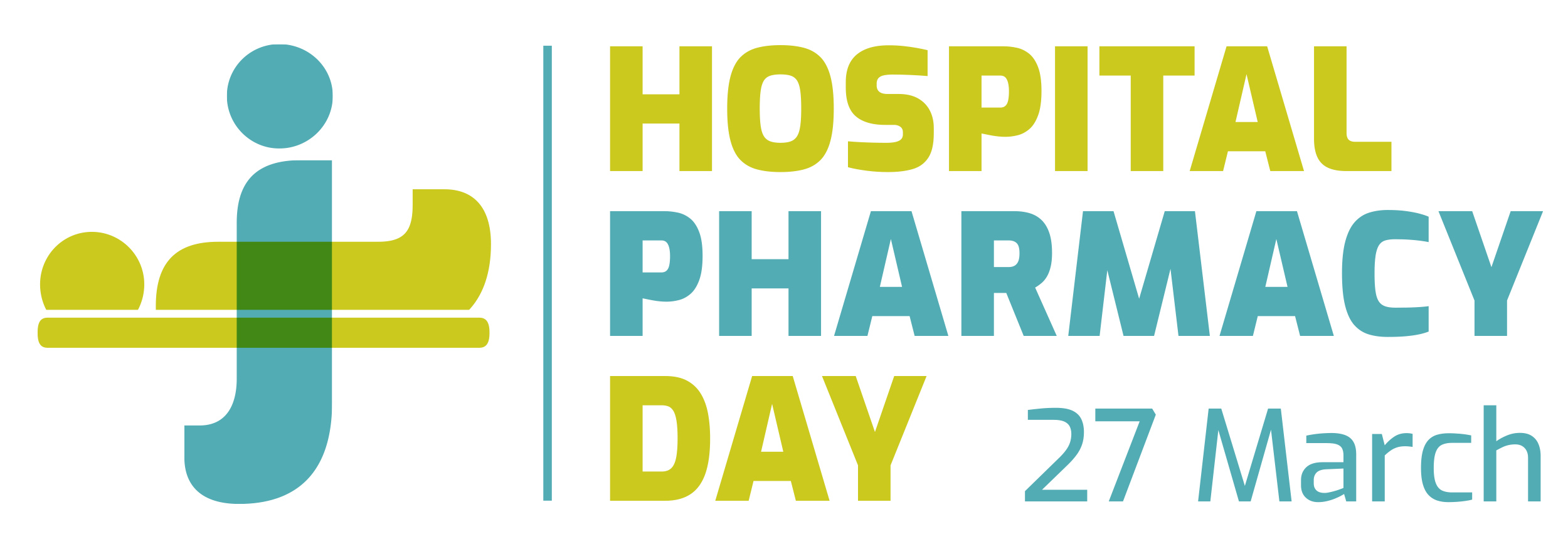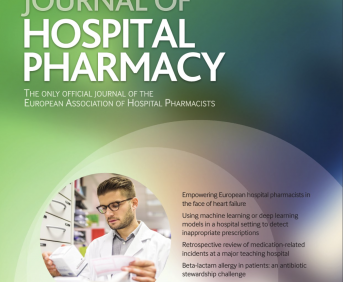DEVELOPMENT AND IMPLEMENTATION OF “CHECK OF TREATMENT APPROPRIATENESS” IN A LARGE TERTIARY CARE CENTRE
European Statement
Clinical Pharmacy Services
Author(s)
Tine Van Nieuwenhuyse, Sabrina De Winter, Isabel Spriet, Thomas De Rijdt
Why was it done?
During the last decade, healthcare shifted in many ways towards a more patient-focused rather than a disease-focused approach. Hospital pharmacy services experienced a similar development. Traditional drug-oriented services expanded towards patient-oriented services by imbedding computerized clinical decision support (CCDS) in the prescribing process and implementing bedside clinical pharmacy services, both leading to improved efficacy and safety of medication use. However, due to limited resources, clinical pharmacy services are not implemented on a hospital-wide basis in Belgian hospitals.
To guarantee patient safety throughout the hospital, emphasizing patients at risk, we started in March 2016 with the development and implementation of central check of medication appropriateness.
What was done?
Development and implementation of central check of medication appropriateness (COMA) in hospitalized patients in a 2000-bed academic hospital.
How was it done?
Based on a risk analysis, high risk prescriptions are checked by a hospital pharmacist for appropriateness. A daily check (0.5 FTE) of automatically generated queries is performed using standardized algorithms. The queries are a result of the screening of all new prescriptions in the electronic prescribing system of the last 24 hours. If an urgent intervention is necessary, in case of a serious adverse event, a phone call is carried out to the treating physician. In all other scenarios, interventions are performed via electronic warnings in the patient’s file.
What has been achieved?
– Development of 75 specific algorithms covering 5 pharmacotherapeutic areas of interest: drugs with restrictive indication, medication-related biochemical changes, evaluation of overruled interventions raised by CCDS, reimbursement of drugs, sequential therapy for bio-equivalent drugs.
– Education of 8 pharmacist involved in the COMA
– During a 6-month period, 19220 prescriptions were checked for which 8284 (43%) electronic warnings were sent and 224 (1%) phone calls were carried out. When analysed without automatic warnings for sequential therapy, 11751 prescriptions were checked for which 815 (7%) electronic warnings were sent and 224 (2%) phone calls were carried out.
What next?
For the future we obtain next goals:
• Evaluation of the current COMA, with emphasis on improving specificity
• Development of new algorithms , also expanding to other areas of interest
• Development of an easy access training tool for hospital pharmacist to perform COMA
PIM-CHECK: DEVELOPMENT OF THE FIRST ELECTRONIC PRESCRIPTION-SCREENING CHECKLIST TO SUPPORT HEALTHCARE PROFESSIONALS IN THE DETECTION OF POTENTIALLY INAPPROPRIATE MEDICATION
Pdf

European Statement
Clinical Pharmacy Services
Author(s)
Aude Desnoyer, Anne-Laure Blanc, Christian Skalafouris, Rolf Hauri, Alain Lorenz, Pascal Bonnabry, Bertrand Guignard
Why was it done?
PIM (i.e. over-/under-/mis-prescriptions, and drug interactions) occurs frequently and is a well-known risk factor for adverse drug events and morbi-mortality (1). Its incidence is high and underestimated in internal medicine (2). While many paper checklists, providing explicit statements, related to PIM in geriatrics exist (3), none had been developed for adults in internal medicine. Moreover, as all these tools are only available as paper versions, they are not easily accessible in daily practice (4). Therefore, we decided to develop an electronic checklist, dedicated to adults in internal medicine.
What was done?
We developed an electronic screening checklist to detect potentially inappropriate medication (PIM) in internal medicine.
How was it done?
We conducted a 4-step study including literature review, 17 semi-structured interviews, a 2-round Delphi survey, and a forward/back-translation process (French English) to develop PIM-Check (5). Sixty-five medical specialists and pharmacists, from 22 hospitals in Belgium, Canada, France, and Switzerland were enrolled. Experts agreed on 160 statements, in 17 medical domains, and 56 pathologies. These statements were then integrated in a specifically developed web-based electronic tool. Each statement is associated with at least one pathology and one medication (1600 ATC encoded).
What has been achieved?
The application is available in French and in English on a website (www.pimcheck.org). A “Screening” function allows users to select for a specific patient, his/her co-morbidities and medications to switch on statements that are the most relevant. A “Favourites” function, gives quick access to selected statements, and a “Learning” function gives access to the list of all statements, those unread and those already read. Details regarding the conception of the tool, direct access to the references (n=333) and useful links (n=29), publications related to the tool and a contact section, are also available. Between February and September 2016, PIM-Check has been visited more than 75.000 times, in over 66 countries.
What next?
Several studies assessing the impact of PIM-Check are ongoing. The algorithm and content of the tool are constantly updated. Thanks to the English version, PIM-Check can be used in different European countries and healthcare settings (6), and will be helpful to support clinical pharmacists’ education in appropriate prescription analysis.
PATIENT-CENTRED CLINICAL PHARMACY AND MEDICINES INFORMATION SERVICE ON A PSYCHIATRIC INTENSIVE CARE UNIT
Pdf

European Statement
Clinical Pharmacy Services
Author(s)
Caroline Hynes, Dolores Keating
Why was it done?
Psychiatric intensive care is for patients who are in an acutely disturbed phase of a serious mental disorder. Psychotropic medicines play a pivotal role in the treatment of these disorders which is why the pharmacist is a key part of the patient care team. The introduction of a designated pharmacist to address not only the clinical needs of the PICU team but also the medicines information needs of the patient was essential to optimise patient outcomes.
What was done?
A liaison pharmacist was assigned to the psychiatric intensive care unit (PICU) to provide both a clinical pharmacy service including regular medication chart review and development of patient-centred clinical guidelines, and to provide medicines information and support directly to patients.
How was it done?
The main obstacle to the introduction of this initiative was establishing a relationship with patients, as visible pharmacist interventions were new to patients on the PICU. In order to overcome this obstacle, the pharmacist was required to be present on the unit and regularly meet patients to enquire about their experience of taking medicine for their mental health and provide information as required.
What has been achieved?
• The pharmacist hosts a weekly medicines information group on the unit where; medicines are discussed openly, patients are provided with medicines information leaflets and medicines charts detailing all of their current medicines and what they are for, and those taking antipsychotics are systematically assessed for side-effects
• The pharmacist carries out a regular clinical pharmacy review where medication charts are clinically assessed and any interventions are relayed to the relevant consultant psychiatrist and registrar
• The pharmacist develops new patient-centred guidelines for use on the PICU e.g. Guidelines on the pharmacological prevention and management of violence or aggressive behaviour
What next?
By having an awareness of the patient experience of their medicine (especially side-effects) through regular contact at the medicines information groups, the pharmacist is in a position to provide more informed clinical advice to the PICU team. This patient-centred approach to the clinical pharmacy service could be transferred to any healthcare setting where the pharmacist can link directly with both patients and their multidisciplinary team.
Development of a guide intravenous administration
European Statement
Clinical Pharmacy Services
Author(s)
Gregorio Romero Candel, Esther Domingo Chiva, Jose Marco del Rio, Marca Diaz Rangel, Wals Valladolid, Sergio Plata Paniagua, Nuria Maryinez Monteagudo
Why was it done?
Critically ill patients often require the administration of several intravenous drugs. Besides, we have many times limited intravenous accesses in which the administration of drugs and other intravenous compounds such as parenteral nutrition must be shared.
Because of that, it is very important to have drug administration guides standarizing every-day clinical practice.
This guide was developed in order to reduce the health care workers burden and promote patient’s safety.
What was done?
We developed an updated guide on direct intravenous administration of drugs for health care workers of both critical care and emergency departments.
How was it done?
A database with every intravenous drug that is included in the Pharmacotherapeutic Guide in our hospital was prepared, alphabetically organized by Active Pharmaceutical Ingredient (API). The following data were collected: API, tradename, available dosage forms and recommendations for direct intravenous administration.
For each API, a bibliographic research of information was conducted, among other hospital administration guides, manufacturer´s product information, drug databases (BOT plusR, Micromedex) and requests of information to the technical departments of the manufacturer.
In case of a discrepancy in the information, the guide with higher evidente or more recent was selected.
The antineoplastic drugs were not included in this guide because they are not used or prepared in critical care or emergency departments.
What has been achieved?
This guide promotes safe administration of drugs in critically ill patients, being a useful, accesible and easy-to-use tool for nurses.
Its elaboration allows us to standarize the direct intravenous drug administration, to inform every health care worker and make them aware about its importance. Besides, the Pharmacy Department actively participated in the process of safe drug administration in our hospital
What next?
We are still working on the same departments to improve safety in drug therapy in critically ill patients. Currently, improvement measures that are being developed are: new pharmacotherapeutic protocols specifically for this unit; drugs and drug-diluent compatibility guidelines and new training sessions.
Obtaining patient feedback via a forum group
European Statement
Clinical Pharmacy Services
Author(s)
Ishrat Saddiq Ali, Gemma Harris
Why was it done?
The idea behind setting up this group was inspired by passionate Pharmacy Team members who wanted to ensure that the Department was abiding by the Trust’s promises and standards for patient care, making sure that patients feel welcomed, cared for and in safe hands, and to raise the profile of the work carried out by the Hospital Pharmacy Team.
What was done?
In October 2014, the Pharmacy department set up a Pharmacy Patient Forum Group (PPFG).
The main aim of PPFG was to discuss ideas and share experiences from patients to support the Pharmacy Department, regarding implementing new changes to enhance patient safety and experience. This would support in delivering the Trust’s objectives for becoming best in class for patient experience.
How was it done?
Meetings are arranged approximately every 6 weeks and attended by:
• Trust Membership and Engagement Manager
• Pharmacy staff – Senior Pharmacist and Ward Based Services Technical Manager
• Trust members
Patient representatives were given a complementary tour of the Pharmacy Department where they could see the workforce in action and appreciate the workload of the team. The tour included:
• Dispensary
• Aseptic Unit
• Out of hours Medication Area
• And a visit to the Admissions ward where they saw the Ward Based Pharmacy team in action.
What has been achieved?
Several projects are being carried out simultaneously. The main project arose when patient representatives raised concerns about correctly identifying indications of medicines due to polypharmacy. We have designed a universal sticker images to enable patients to identify indications when faced with language barriers or vision problems. We have successfully developed a cardiology, indigestion/heartburn and pain specific sticker.
We have gained approval from other specialities regarding the images.
Another project focussed on tackling patients’ negative perceptions about discharge delays regarding medication. Patient representatives were invited to view the MEDI-365 automated dispensing machine which are utilised by Ward Based Clinical teams. This led to patient representatives viewing the pharmacy Prescription Tracking System (PTS) which is used to provide live information to all ward staff about pharmacy workload and track patients’ medication. The PTS has been further refined to produce a label which is attached to discharge medication detailing the time taken to process the prescription.
Patient representatives reported that they welcomed the opportunity to see a Pharmacy Department functioning within a busy District General Hospital
What next?
• We are looking to involve local primary schoolchildren/college students in the design of future images. This will aid in helping strengthen local community relations and raise awareness of the projects.
• We are currently working on producing a Discharge Leaflet explaining the Pharmacy Discharge Pathway.
• We find it extremely beneficial to meet via PPFG. We are keen to pursue with these meetings so we can work in collaboration on future initiatives to improve patient experience and safety
We have currently showcased our work in the following:
• Article published in Membership Connect Magazine in September 2015
• Article published in the PJ recently(http://www.pharmaceutical-journal.com/opinion/correspondence/obtaining-patient-feedback-via-a-forum-group/20201596.article)
• Presentation given to ‘Friends of Expert Patients Programme’ September 2016
• We have submitted an application to West Midlands Innovation Day to consider our work
• Article published in the Trust Connect Magazine in October 2016
A PHARMACIST IN THE MULTIDISCIPLINARY ONCOLOGY TEAM
Pdf

European Statement
Clinical Pharmacy Services
Author(s)
Ulrike Guger-Halper
Why was it done?
The pharmacy of the hospital supplies four hospitals with cytotoxic infusions. In the past it was found that the integration of a pharmacist in the oncology team brings benefits.
What was done?
Integration of a pharmacist in the oncology team
The aim was to evaluate the participation of a pharmacist in the multidisciplinary oncology team. The team consists of the clinical pharmacist, medical oncologists, residents, oncology nurses, dieticians, medical documentation assistent and a clinical psychologist.
How was it done?
Data were collected from May 2014 to September 2015.
All chemotherapy protocols were electronically prescribed in CATO® (computer aided therapy for oncology) and included cytotoxic drugs and concomitant medications.
In addition to production in the cytostatic unit the pharmacist participated in the daily morning meetings, the two-week tumor boards and bimonthly team meetings.
Pharmacist interventions (PI) took place during the meetings and were also communicated by phone and mails.
What has been achieved?
3335 cycles of chemotherapies were prescribed and 914 interventions were recorded.
CATO®-related PI (33,3%) were categorized in: literature research (4,7%), chemotherapy protocols (3,2%), dose selection (16,7%), treatment duration (1,4%), application/infusion time (0,9%) and others (6,4%).
Not CATO®-Related PI (66,7%) were categorized in: logistics (24,2%), patient-related (26%), drug-related (16,5%)
Under pharmaceutical participation: 15 guidelines, 1 abstract for a poster presentation, 27 work tools, 2 workshops, 2 publications, 1 lecture, 15 staff trainings, wipe samples in preparation
What next?
In this observational study we demonstrated the significant role of the clinical pharmacist as a part of the multidisciplinary oncology team. The supply by a pharmacist means to optimize treatment protocols and procedures and improving patient safety.
Medication errors occur despite electronic prescription of standardized protocols. Clinical pharmacists with special experience in oncology play an important role to identify errors in oncology.
A plausibility check by a pharmacist is still needed.
References: Sessions J. K. et al., Role of Oncology Clinical Pharmacists in Light of the Oncology Workforce Study, J Oncol Pract. 2010 Sep; 6(5): 270–272.
SEAMLESS PHARMACEUTICAL CARE OPTIMISING ANTICOAGULATION MANAGEMENT IN THE PERIOPERATIVE PERIOD
European Statement
Education and Research
Author(s)
F. Reidy, M. Duggan, A. Mathew, G. Duignan, S. Nasim, H. Ryder, B. Giblin, B. O’Connell, J. Corcoran
Why was it done?
The management of patients on oral anticoagulant drugs in the perioperative period has become confusing due to the introduction of:
– Newer oral anticoagulant and antiplatelet drugs
– Increased number of day case surgeries and early discharge, leading to lack of optimum care of patients, with anticoagulation and thrombophylaxis measures being undermanaged, resulting in prolonged hospital stays and cancellations of procedures.
What was done?
Following informal discussions with pre-assessment clinic (PAC) nursing staff, anaesthetists, pharmacists and surgeons, an evidence based management plan for thrombophylaxis and anticoagulation in the perioperative period for surgical patients was developed comprising of:
Thromboembolism risk assessment and bleeding risk stratification tool, to risk stratify all patients being admitted for surgery.
Prescribing guidelines on the management of anticoagulant drugs in the perioperative period.
Patient information leaflets on the management of anticoagulant drugs and thrombophylaxis measures pre and post procedure.
Preprocedure and discharge pharmaceutical plans to facilitate patients’ anticoagulation drugs to be managed effectively in the community.
How was it done?
Draft guidelines were disseminated to relevant staff and an opportunity was given for feedback over a period of 1 month. Following these recommendations, the guideline was introduced at the weekly surgical meeting. Information was then disseminated to the relevant departments.
One year later an audit demonstrated that these guidelines provided clarity with the decision making process regarding anticoagulation and thrombophylaxis, resulting in improved patient safety outcomes in the perioperative period. The need for educational training on the guidelines and simplification of the risk assessment tool was highlighted.
What has been achieved?
• Patients’ anticoagulation needs pre and post procedure can be managed with clear instructions in the perioperative period across the hospital/community interface.
What next?
The tool will be adapted to help with the decision making process regarding anticoagulation and thrombophylaxis for medical patients.
The complexities of perioperative anticoagulation are addressed in a simple way that the development of an App would benefit patient safety.
IMPLEMENTATION OF A SAFETY AND HEALTH PROGRAMME FOR THE MANAGEMENT OF PATIENTS WITH HEPATITIS C RECEIVING TREATMENT WITH DIRECT ACTING ANTIVIRAL AGENTS
Pdf

European Statement
Clinical Pharmacy Services
Author(s)
S. IBAÑEZ GARCIA, C.G. RODRIGUEZ-GONZALEZ, A. GIMENEZ-MANZORRO, E. CHAMORRO DE VEGA, R. COLLADO-BORELL, E. LOBATO-MATILLA, A. DE LORENZO-PINTO, M. TOVAR-POZO, A. HERRANZ-ALONSO, M. SANJURJO-SAEZ
Why was it done?
CHC affects approximately 3% of the world’s population. The development of well tolerated and effective AADs has changed the therapeutic landscape. These therapies have a high efficacy with a good safety profile. Numerous challenges in terms of patient education, monitoring, medication errors, drug interactions and adherence exist. Our National Health System launched a strategy plan for proper CHC management in April 2015, establishing, among other things, measures to optimise AAD use.
What was done?
We have developed a pharmaceutical care programme.
I. The following protocols were defined:
– A case selection and treatment guideline, following the recommendations from health authorities.
– A protocol for the management of drug interactions.
– A protocol with recommended dosages and administration techniques.
– A protocol with potential adverse drug events and recommendations about how to prevent and manage them.
– A protocol about clinical interview to ensure patient literacy and co-responsability.
– Patients information leaflets.
II. The pharmacy department was provided with:
– 3 full time pharmacists.
– 2 patient information offices.
– a queue management system.
III. Appointment scheduling:
Pharmacy visits were scheduled after the hepatologist/infectious disease specialist appointments every 28 days.
IV. The clinical interviews were documented in the electronic health record.
How was it done?
A multidisciplinary team was formed with two hepatologists, one infectious disease specialist, three clinical pharmacists and one nurse to:
– Address the key points associated with the safe and efficient use of AADs.
– Create a useful clinical guideline.
– Identify staffing and logistics needs.
What has been achieved?
No of patients included in the programme: 674
No of initial visits: 674
No of follow-up visits: 1750
No of patients attended/day: 19.9
No (%) adherent patients at the end of treatment: 412/412 (100%)
No of pharmacist interventions: 195
No (%) pharmacist interventions accepted: 194 (99%)
Average waiting time to be attended by the pharmacist: 15 min
No of queries made to the hospital pharmacist: 84
No of adverse drug events reported to the pharmacovigilance centre: 31
Cost savings (€): 121 194
What next?
This initiative provides a set of recommendations regarding CHC management and a support guide to standardise and guarantee high quality pharmaceutical care.
The next step is to develop pharmaceutical care programmes for the management of other pathologies following the same methodology that we have used for this initiative.
IMMPACT: A THERAPEUTIC EDUCATION PROGRAM TO SUPPORT SEAMLESS CARE FOR PATIENTS LIVING WITH CANCER
Pdf

European Statement
Clinical Pharmacy Services
Author(s)
A. Decottignies, D. Bouchoucha, S. Lévêque, S. Barthier, J.F. Morere, A. Marfaing, A. Rieutord
Why was it done?
Cancer has become a chronic disease. However, the impact of the disease and related treatments on patients’ everyday life remain poorly addressed all along the patient clinical pathway. The objective was to customise support to the patient to be able to better understand and control the disease and treatment consequences.
What was done?
An integrated care model based on a therapeutic education programme (TEP) was designed to better support patients living with cancer in their everyday life. The hospital pharmacy led the project, launched in October 2013 and implemented for patients in March 2015. It is called IMMPACT (impact of illness and medication in patients undergoing chemotherapy). This TEP was accredited by the National Authority (ref No ETP 13/30 in August 2013).
How was it done?
A transprofessional working group was formed. Our concern was to propose a smooth and safe transition from hospital to home. To do so, the hospital set up a partnership with the health network to facilitate seamless care. A prospective survey was conducted in October 2013 including 41 ambulatory patients. Three priority themes were identified: tiredness, haematological problems and digestive disorders management. According to the results, educational sessions have been collaboratively designed and implemented.
What has been achieved?
The patients group workshops began in January 2014. To date, 31 group workshops have been run. These group workshops are facilitated by trained healthcare professionals using educational tools such as Barrows Cards, mosaic characters or metaplan. 83 patients have already experienced this programme. Patient global satisfaction is >92%.
What next?
Given the success of this programme and to fulfil the growing expectations of patients, new sequences are being designed about pain, chemotherapy related neurotoxicity, socio-aesthetics and lymphoedema management as well as developing a serious game for the patient. Finally, IMMPACT extension to community pharmacists is being considered to further sustain patients empowerment and continuity of care.
BREAKING BARRIERS: MEDICATION SAFETY IN TRANSITIONS OF CARE
Pdf

European Statement
Clinical Pharmacy Services
Author(s)
M. Cabré Serres, T. Aguilella Vicente, E. Julián Avila, D. Rodríguez Cumplido, J.M. Pepió Vilaubí, M. Muñoz-García
Why was it done?
As a part of a multicentric medication reconciliation (MR) study in the fragile patient, one of the phases of the project included primary care reconciliation so we had to create alliances and enable effective communication channels between the two levels of care.
What was done?
During 2015, we started using direct messaging between hospital pharmacist (HP) and primary care physician. The messaging tool, which is available in SIRE and ECAP programs, allows you to send messages to all physicians caring for the patient. It also allows you to contact the usual pharmacy of the patient. Physicians receive messages automatically during the patient’s clinical course.
How was it done?
When patients were medically discharged, the HP performed MR. The HP contacted the next provider to inform them of changes in the medication list and safety alerts. When the patient visited the doctor, he already had the pharmacotherapy summary and pharmaceutical recommendations in the patient’s electronic clinical course. Afterwards, the HP assessed if the pharmaceutical interventions (PIs) had been accepted.
What has been achieved?
We started using the tool in January 2015. We performed 205 discharge reconciliations and have sent 143 messages. This would be 0.7 PIs/patient. PIs have been: 26.6% (n=38) remove medication, 21.0% (n=30) monitor treatment, 21.0% (n=30) increase adherence, 11.2% (n=16) modify dose, 8.4% (n=12) add medication, 6.3%(n=9) modify posology and 5.6% (n=8) replace medication. Finally, 72.7% (n=104) of PIs have been accepted and 27.3% (n=39) rejected. We can also analyse population characteristics and the drugs involved in the PIs.
What next?
We are breaking barriers between hospital and primary care with nexus of the HP, who has begun to be part of the medical team. We want to continue in this direction to improve the results of our PIs. We want to determine if our PIs improve health outcomes. Another current problem in the transition of care is hyperprescription treatments with proton pump inhibitors or benzodiazepines. A de-prescription programme could be the next step.
